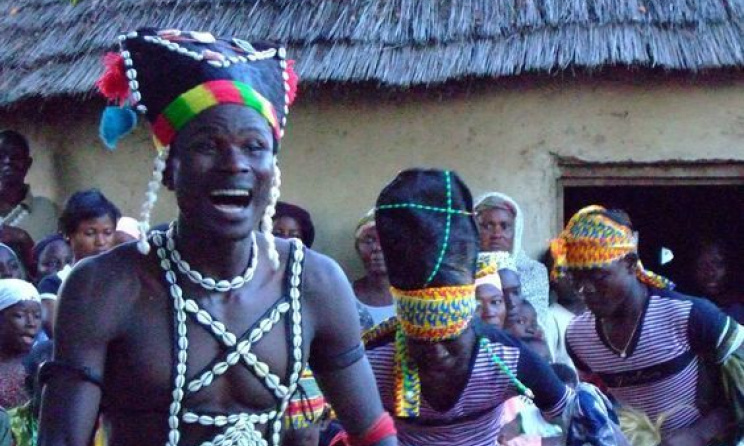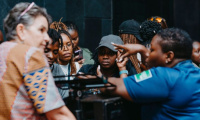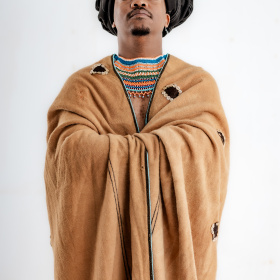Traditional music in Chad
The practice of traditional music is alive in Chad, country of the Toumai, which has over 250 ethnic groups contributing to its cultural richness and diversity.
 Traditional dancers. Photo: Pinterest
Traditional dancers. Photo: Pinterest
A common practice
The first President of the Republic of Chad, Ngarta Tombalbaye (1960-1975) was a huge fan and promoter of traditional music, which was performed at every official ceremony thereby promoting several artists from the 1960s, whose works represent a common heritage. Artists like Issa Moussa, Moussa Chauffeur, Djingayam, Ngon Koutou, Maman Eldjima, Morsilé, Doumi Thomas and the president’s favourite, Toudjibé, have all left their mark.
Alifa Day Daniel is the last survivor of a generation who honoured traditional music. Thanks to Maître Béchir Madet, a notary who was surprised to learn that Alifa Day Daniel was still alive, "The last of the Mohicans" stepped into the studio in March 2011 to record a unique album. His first concert afterwards was a memorable event.
Maître Béchir Madet, who is the President of the Association pour le Développement Culturel (Adec), also contributed to "La nuit des balafonistes", an annual event which brings together balafon-players from different regions, valuing and perpetrating an ancestral art while inviting young Chadians to get to know and take ownership of their heritage. Sem Ta Doua festival, another event dedicated to traditional music, was initiated in 2011 in Moundou by Maskemngar D., also known as Djim Black, through his association Tchad Héritage.
Every year, traditional musicians from the four corners of Chad gather for the event, which lasts 3 to 4 days "promoting traditional music and making it available to the public through this festival, while passing on our cultural values and customs to the youth," said Djim Black.
Traditional music in Chad remains popular and is frequently requested at events or on radio.
Diversity of instruments
When listening to Chadian traditional music, one is struck by the similarities of regional sounds. Its magic lies in the nuances and the handling of instruments and sounds. String instruments (lute, vithele) are common in the Saharan and Sahel regions. Wind instruments are found in the Sahelian areas represented in the past by the sultanates (Ouaddaï, Kanem and Chari-Baguirmi). In the southern region, harps (arched or angled) as well as the bala (xylophones) generally accompany the singer and are specific to each region.
Flutes, locally known as tob, nals or algueita, are found in the central and southern regions. Drums, manufactured from various materials, are found in all communities in Chad. The introduction of western instruments, since the independence, continues to be considered by artists as a sign of emancipation, but this has never impacted traditional music.
Today, musicians owning and using modern instruments turn towards traditional music. The country is witnessing a crossbreeding of ancestral rhythms, mid-way between tradition and modernism.
Doro, the medium between traditional and modern music
Doro Dimanta, who has been living in France for thirty years, returns regularly to the country. He is the Dean of Chadian jazzmen and comes from a long line of traditional musicians. “Pastor Moussolnan, who was my father (may god rest his soul), was a famous balafon player," he said. "My uncle Bénoudjita was a talented zither and sanza player. They followed spiritual and religious paths and I followed their path."
He added: "My musical roots are in fact deeply natural. I have a paradoxical approach because I cherish traditional music and perform modern and contemporary music. Today I am working in the narrative world. According to the Chadian tradition, when one hears a famous balafon player, he speaks and yet it is the music. I am speaking to you yet, all the flow of my voice is musical. I am working on musicality and lyrics like our traditional musicians. I understood this and I work to perfect my art so that my music is speech and my word music. It is a little complicated."
"Strength in the tradition, technicality and reflection are in modernity," he said. "When you use a guitar or a keyboard, these are European instruments and you must adapt to your Chadian culture or African descent. It is an important aspect of the work. Music expresses culture. And a good artist is one who seeks. There is no music in an absolute way. There are different types of music adapted to each people and each situation. And I would like young people to understand this."
References- Journal du Tchad: www.journaldutchad.com/
- Wikipedia : https://fr.wikipedia.org
- Blog Witantoua la Tchadienne: http://witantoua-la-tchadienne.over-blog.com
- Tchad par Dominique Auzias et Jean-Paul Labourdette, Petit Futé



















Comments
Log in or register to post comments